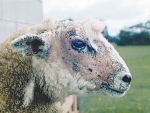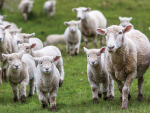FACIAL ECZEMA (FE) occurs when grazing animals eat pasture containing large numbers of spores from the fungus Pithomyces chartarum. They contain sporidesmin, a toxin which causes inflammation of the liver and bile ducts.
The damage is incremental, and disease occurs both from short-term ingestion of pasture with high spore counts and long-term ingestion of pasture with more moderate spore counts. While the cow's liver has some capacity to heal and regenerate, there is often long-term compromise of its function.
One immediate effect of exposure to sporidesmin is a drop in production and there may be transient diarrhoea. The toxin is concentrated in bile where it generates free oxygen radicals (super-oxides) which cause massive cellular damage especially in the bile ducts. This damage blocks the flow of bile, allowing the light-reactive substance phytoporphyrin (also known as phylloerythrin) to accumulate in blood and tissue fluids making the animal photosensitive.
Phytoporphyrin is produced during microbial fermentation of the green plant pigment chlorophyll in the rumen but is cleared through the bile when liver function is normal.
When it accumulates, if lightly pigmented skin is exposed to sunlight, the resulting deep tissue burns to produce the characteristic skin lesions of FE. This disease process has a time lag, so skin lesions do not become evident until 10-14 days after spore ingestion.
Severe skin lesions do not heal well, and cows may develop 'skin horns' on affected areas. Sometimes the toxin causes circulating red blood cells to break down and blood pigments will stain the urine red (red water). Sporidesmin is also excreted through the kidneys and can cause cystitis and frequent urination.
Only about 10% of affected animals show clinical signs: for every clinical case there will be 10 cows with sub-clinical FE4. The extent of subclinical disease can be monitored by measuring levels of gamma glutamyl transferase (GGT) in blood which is closely correlated with the amount of liver damage. Levels of 250 IU/L indicate moderate damage. Sub-clinical FE cows may show clinical signs after cumulative doses of toxin, or they may lose production and body condition, be unable to regain condition after drying off, or suffer liver failure and "spring eczema" (photosensitisation signs) early in the subsequent season.
Predicting risk
Spore numbers increase in summer and autumn; January to May are the high-risk months. Conditions are favourable for spore production when overnight minimum grass temperatures stay at or above 12°C over four consecutive nights, and humidity is high, e.g. with drizzly rain (4-6 mm/48h), or when soil is kept moist by irrigation. In natural outbreaks, spore counts usually show one or two small increases over several weeks, followed by a major rapid rise when the right weather conditions occur.
Given that young spores contain more toxin, pastures are more toxic when conditions promote rapid fungal growth. Conditions for spore growth are also conducive to pasture growth: the amount of dead plant material in the base of the pasture increases, providing an ideal environment for spore production.
Making animals graze into the pasture base adds to the risk.
The risk of exposure to the toxin is traditionally predicted by counting spores, which look like microscopic hand grenades, in pasture washings. This gives a useful prediction of risk, but there are two caveats: 1) fungal growth does not occur evenly across a farm, or indeed across a paddock. Counts may be higher in 'hot spots' such as sheltered

















